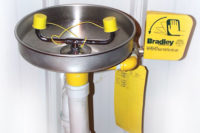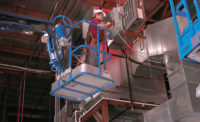Bottles vs. other eyewashes
The OSHA standard does not provide a great deal of detail on eyewashes for employers. However, where the regulation is silent, OSHA refers employers to the American National Standards Institute (ANSI) standard Z358.1-2009, “Emergency Eyewash and Shower Equipment,” regarding installation, operation and maintenance of emergency eyewashes. This includes capacity and flushing requirements. The ANSI standard states that an eyewash must deliver 0.4 gallons of flushing fluid per minute for at least 15 minutes.
As such, ANSI says that an eyewash bottle does not meet this criteria; therefore, can only be used to support eyewashes that do (i.e., plumbed and self-contained units), but cannot replace them.
Capacity
The reason for this limitation is that eyewash bottles simply do not have the capacity to provide the required 15 minutes of flushing. Eyewash bottles typically hold less than a gallon of water, which would supply the user with flushing fluid for approximately 1 minute. Even larger self-contained units (those with bladders) that have a capacity of 5 to 10 gallons would only provide a maximum usefulness of about 5 minutes.
In other words, eyewash bottles do not provide an adequate amount of flushing fluid and cannot be considered a primary means of protection.
Limitations of use
For this reason, OSHA warns that the use of eyewash bottles should be limited.
In a 1986 memorandum to Regional Administrators, the agency states, “In general, squeeze bottles should not be used except where the hazard severity or distance from plumbed eyewash equipment requires personal equipment at work stations for immediate flushing prior to prolonged flushing at a plumbed or self-contained unit.”
In other words, employers can provide eyewash bottles in instances where plumbed or self-contained units can’t reasonably be provided (e.g., an outside yard) in the immediate work area, but only until they can reach a unit which can provide the amount of flushing fluid necessary to flush the eyes for at least 15 minutes.
Ultimately, OSHA expects the employer to determine the level of potential risk to employees and provide eyewash (and/or shower) protection accordingly. The severity of the hazard(s) involved is a critical consideration when making this determination.
In the past, OSHA has said of 1910.151(c) that the regulation is meant to cover strong acids and alkalis and the requirement to provide suitable facilities for quick drenching or flushing depends on the exposure and the strength of the hazardous chemical. Chemicals and materials such as household detergents or cleaners, sawdust, metal filings, etc. would not require emergency eyewash (or shower) under the standard.
OSHA enforcement
If an employer determines an eyewash is needed, then it must meet the provisions set forth in ANSI Z358.1-2009. The agency uses the ANSI standard as an enforcement tool. This is clarified in a November 1, 2002, Letter of Interpretation, which says:
“If OSHA inspects a workplace and finds unsuitable facilities for quick drenching or flushing of the eyes and body, a citation under 29 CFR 1910.151(c) would be issued. When determining whether the eyewash or shower facilities are suitable given the circumstances of a particular worksite, OSHA may refer to the most recent consensus standard regarding eyewash or shower equipment….”
Without the ANSI standard, employers would find it difficult to demonstrate to OSHA exactly how their eyewash and shower units were “suitable” exclusive to the regulatory language under 1910.151(c) since it is limited and vague.
In 2011, OSHA issued a $5500.00 serious violation citation to an employer for not providing employees “with an adequate emergency eyewash with a large enough volume in the event of an emergency.” OSHA cited 1910.151(c) which requires that “suitable facilities for quick drenching or flushing of the eyes and body” be provided. Again, if an employer determines that an eyewash is necessary, it must deliver 0.4 gallons of flushing fluid per minute for at least 15 minutes.
Offer other options
Eyewash bottles do not meet the requirement under 1910.151(c) to provide “suitable” facilities for quick drenching or flushing of the eyes. As such, they cannot be the only eyewash provided in a workplace. It’s critical that employers understand their limitations of use to be compliant with the OSHA standard.



